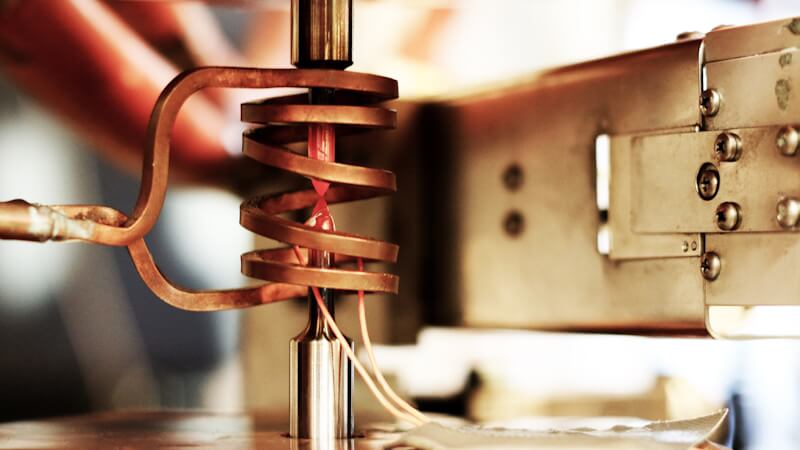The process steam contains contaminated wet steam (a mix of some ppm of NOx and possibly some chlorine and sulfur compounds) with an operating temperature of 130°C and an operating pressure of 0,5 Bar.
The bellows have an average lifetime of two years.
Over the past years:
– The design of the bellows has been adjusted;
– The capacity of the system has been continuously increased;
– The system has been regularly in and out of operation (5-6 stops per month);
– There have been fluctuations in pH (0,3 – 3).
The 304L stainless steel bellows consist of two layers with an original wall thickness of 0.6 mm/layer. On the interior the bellows are shielded by an inner sleeve (a flow plate welded to the pipeline, see figure 1). The inner sleeve is a design from the manufacturer to protect the bellows against mechanical fatigue due to vibrations at flow rates > 10 m/s. The bellows are welded to the 304L pipelines. On the exterior surface the pipelines are completely isolated to avoid condensation of the “contaminated” process steam.
In addition, leak detection tubes are present and connected to the space between the two layers of the bellow. This means that any leakage is detected at an early stage. If the inner layer of the bellow leaks the process steam will exit through the leak detection tubes and be observed. The outside of the 304L bellows and pipeline show almost no corrosion (see Figure 1 & Photo 1). However the inside of the bellows show severe corrosion. The pipeline showed some minor overall roughness on the inside but almost no corrosion.
Results & investigation
One of the leaking bellows was removed for further investigation. Visual-, macroscopicand microscopic examination was done by the firma Element. The bellow was welded to the pipeline using a fillet weld on the outer surface.
The outer surface of the bellow is glossy metallic and does not show any signs of leakage(s) or corrosion. On the inside of the bellow a flow plate is welded (inner sleeve), wherein the (angle) weld is at the top (in flow direction).
This inner sleeve was removed for this investigation, see photos 2 and 3. On the medium side, the result of the investigation of the bellow behind the inner sleeve was:
- The surface was covered with ‘scabs’ of red-brown, blue-gray and black corrosion products;
- The inner layer of the bellow was affected over a larger area, wherein the rate of attack parallel to the surface is higher than the degradation perpendicular to the surface, with a gradual decrease in wall thickness to very thin with local perforations in the end.
Such an appearance is characteristic for the so-called “Mesa type” corrosion (see photo 4 and 5). The pipeline above and below the bellow and the outside of the inner sleeve area show almost no corrosion. This attack is not comparable with the severe attack between the bellows and the inner sleeve.
Local condensation, present either continuously or during start/ stops of the contaminated steam, combined with the concentration of acids (sulphur and chloride) and local low pH, resulted in localized attack of the protective oxide layer. This resulted in open pits and intergranular corrosion.
In this system the design and geometry of the bellows played a negative role for corrosion. It created a stagnant environment where a thickened, contaminated accumulation could occur in the “dead” space behind the bellow and inner sleeve (crevice area). This is the primary failure mechanism which led finally to leakage of the first layer of the bellow.
The inner sleeve is designed to protect the bellow against mechanical vibration failures which can happen at high velocity in the contaminated steam. Our questions are: is a sleeve in this bellow necessary, can the bellow function in a wet gas stream without an inner sleeve, and can we prove that a concentration of aggressive components is taking place? In our environment the sleeve has a negative effect because of corrosion. We are now thinking to solve this corrosion problem by:
- Removing the complete inner sleeve and reducing the crevice areas;
- Purging (with clean steam) behind the sleeve, so process contaminations will be flushed out.
- Change the material to more corrosion resistant alloy for acid condensation corrosion.
A protective inner sleeve in a bellow can cause more damage than what it was initially installed for. We have already seen corrosion phenomena in other bellows with inner sleeves in some of our chemical plants. In several cases we have changed to more corrosion resistant materials, especially for the first layer of the bellow on medium side. We have also changed the design and carried out a steam purge behind the sleeve.
The complete sleeve has also been removed when the corrosion takes place more rapidly than the damage caused by mechanical failures. For every case where corrosion can take place and a bellow with inner sleeve is necessary in the pipeline, you have to consider about the right solution. In some cases we have no stainless steel solution and we have to change to PTFE material, depending on the pressure and temperature.
By Peter Janssen, Senior Technical Support Engineer, Sitech Services, the Netherlands. All photos © Sitech.















